Research Article Open Access
Bioremediation Potential of White Rot Fungi, Pleurotus Spp against Organochlorines
| Saima Sadiq1,2*, M. Inam ul Haq1, Iftikhar Ahmad2, Karam Ahad2, Azhar Rashid3 and Nazia Rafiq2 | |
| 1Pir Mehr Ali Shah, Arid Agriculture University, Rawalpindi, Pakistan | |
| 2National Agriculture Research Centre, Islamabad, Pakistan | |
| 3Quaid-I-i-Azam University, Islamabad, Pakistan | |
| Corresponding Author : | Saima Sadiq Pir Mehr Ali Shah Arid Agriculture University, Rawalpindi, Pakistan. Tel: 92-051-9290466 E-mail: saimasadiqqau@yahoo.com |
| Received July 06, 2015; Accepted August 15, 2015; Published August 22, 2015 | |
| Citation: Sadiq S, Inam HM, Ahmad I, Ahad K, Rashid A, et al. (2015) Bioremediation Potential of White Rot Fungi, Pleurotus Spp against Organochlorines. J Bioremed Biodeg 6:308. doi:10.4172/2155- 6199.1000308 | |
| Copyright: © 2015 Sadiq S, et al. This is an open-a ccess article distributed under the terms of the Creative Commons Attribution License, which permits unrestricted use, distribution, and reproduction in any medium, provided the original author and source are credited. | |
| Related article at Pubmed, Scholar Google | |
Visit for more related articles at Journal of Bioremediation & Biodegradation
Abstract
White rot fungi play significant role in biological dissipation of Organochlorine (DDT, HCH, Aldrin, Dieldrin, Endrin, Endosulfan and Heptachlor) in ecosystem. Relative biodegradation potential of Pleurotus ostreatus(OST-1), Pleurotus pulmonarious (Sajor- Caju)(WC-537),Pleurotus ostreatus( WC-522), A-6 and R-22 (Pleurotus ostreatus) against above pesticides were studied by using GC-ECD. HCH was degraded 84% by OST-1 which is a local strain, followed by A-6 (55%), WC-522 (45%), OST-Belgium (29%) and WC-537 (4%) which are exotic strains of Pleurotus. Maximum Degradation of 4,4-DDT and 2,4-DDT was done by OST-1(67% and 65%)respectively. Influence of A-6 (69%), OST-Belgium (69%) and WC-537 (51%) was more pronounced for 4,4-DDT than for 2,4-DDT with only 14%, 16% and 0% respectively. Exotic strain of P. ostreatus (WC-522) was the most inefficient of the isolates and produced only 3% reduction in 2,4-DDT and no reduction was observed in case of 4,4-DDT. In the study only A-6 and OST-1 were found to produce some reduction while OST-Belgium, WC-522 and WC-537 did not produce any amount of reduction in aldrin and dieldrin quantities. Efficacy of isolates varied significantly with each other for a-endosulfan and b-endosulfan A-6 and OST-1 were found most efficient and at par with each other in reducing the amount of α-and β-endsulfan in bioassay. Mean maximum reduction of Endrin 32% was recorded in WC-537 followed by 29% in WC-522 and 14% in OST-Belgium. Isolates also vary greatly in degradation of heptachlor. Based on results it is highly recommended to use local Pleurotus isolates of Particular area where bioremediation need to be done.
| Keywords |
| Bioremediation; Genus Pleurotus; White rot fungi; Organochlorines |
| Introduction |
| Organochlorine (OCPs) are persistent, toxic substances and have a tendency of long range transport in all components of ecosystem [1] in environment. Through process of biomagnification OCPs appear in food chain [2] and cause several organochlorine linked toxic effects on all components of ecosystem. Organochlorines are carcinogenic and mutagenic and are reported to possess estrogenic activity. Most developed countries stopped using these pesticides after imposition of ban but developing or underdeveloped countries could not due to lack of policy [3]. White rot fungi (Basidiomycetes:Xylariaceae) are popular among all fungi as these can tolerate high concentration of pesticides from mix-load sites [4]. Several isolates of white rot fungi have been used since 1985 for biodegradation of OCPs. First isolate reported in this regard was Phanerochaete chrysosporium was reported in degradation of recalcitrant organic pollutants [5] and its capability was highlighted for metabolizing these pollutants due to lignin degrading enzymes system and similar degrading capacity was described for other white rot fungi. Lignolytic (Oxidative extracellular) enzymes like Manganese peroxidases (MnP), Lignin Peroxidases(LiP) and Laccases(Lac) from white rot fungi make them adaptable to colonies its mycelium and give fruiting bodies on variety of growth substrates [6]. |
| Pleurotus spp. like all other white rot fungi, possesses medicinal, biotechnological and environmental applications [7]. Lignin degrading systems of Pleurotus are extracellular in natures which make them able to degrade lignin and wide range of Organic pollutants [8] due to structural similarity with organo pollutants. Much of work regarding white rot fungi and biodegradation is done using Phanerochaete chrysosporium. One of advantage of using Pleurotus instead of Phanerochaete chrysosporium in biodegradation of polluted soils is advantageous as temperature necessities of Genus Pleurotus which are lower than that of P. chrysosporium [9]. Its hyphae can penetrate into soils, reach pollutant much faster than any other fungus [10]. |
| Biodegradation of organo chlorines lindane by subtropical white rot fungi have been extensively studies [11]. Biodegradation of DDT and Lindane was also reported by Pleurotus ostreatus [12]. Literature showed many reports regarding single pesticides degradation by one isolates or two isolates of white rot fungi [13] but no comparative work was available to determine the relative potential of different strains and spp. of Pleurotus for biodegradation of OCPs. This study was conducted to determine the biodegradation potential of different local and exotic strain and spp. of Pleurotus against toxic and well known organochlorine pesticides. |
| Materials and Methods |
| Selection of reagents and chemicals |
| Pesticides reference standards (Purity >99%) of HCH, DDT, α-and β-Endosulfan, Aldrin, Dieldrin, Heptachlor and Endrin used during bioremediation studies were purchased from Dr. Ehrenstorfer Laboratories (Augsburg, Germany).Analytical grade n-hexane and acetone and reagent grade sodium sulphate anhydrous (Na2So4) purchased from Merck Co. (Darmstadt, Germany). |
| Collection and Maintenance of Isolates |
| All local and exotic isolates (Table 1) were cultured and maintained on malt extract Agar (MEA) by using the method of Mane et al. [14] |
| Biodegradation assay in liquid medium |
| Efficacies of Pleurotus isolates were studied for each organochlorine separately in liquid culture bioassay in 50ml Erlenmeyer flask. 150μg/L of OCPs Pre-autoclaved liquid Malt Extract (10ml) was spiked at rate of 150 μg/L prepared from 1000μg/L standard solutions (prepared in n-hexane). Unspiked ME was used as control. All flasks including control were inoculated with 0.5 mm of mycellial plug of actively growing fungal species. For quality control, media spiked for each OCP (Organochlorine Pesticides) was left un-inoculated. Each treatment and control was replicated three times and incubated by placing on mechanical shaker @25 rpm at 25°C in dark until maximum growth of all isolates achieved. For analysis of leftover amount of OCPs, GC-ECD was used. |
| Extraction and analysis |
| Extraction of OCPs analytes from Liquid malt extract was performed by Liquid-Liquid Extraction method [15] Contents of flasks were transferred to 50ml centrifuge tubes and 10ml each of n-hexane and water were added into it. After vigorous shaking for 1min all the tubes were centrifugeda5 5000g for 5min. An aliquot of 8ml was transferred to round bottom flask. Gentle Stream of Nitrogen was used to evaporate the excess solvents to near dryness. Concentrated extract were reconstituted in 1ml n-hexane and stored 1.5ml Amber GC-Vials (Amber glass). Analysis of extracts was done by auto- system gas chromatograph (GC) Perkin Elmer, USA) equipped with electron capture detector(ECD-Ni63). Fused silica capillary column (PE-3, phase methyl 10% phenyl silicon, 25m, 0.32 i.d., 0.5mm o.d.,0.5μ film thickness, Perkin Elmer, USA) was used for chromatographic separation of analytes. Turbochrom4 R data analysis hardware/ software system was used for data acquisition and data analysis. Initial oven temperature was 100C for 0.5min, ramped to 160C at 15C /min, again ramped to 190C at 2C/min and finally ramped to 220C at 15C/ min and held for 1min. Detector temperature was held 300 oC. High Purity nitrogen gas (99.999%) was used as carrier gas at flow rate of 12ml/min (21psi). Identification was based on retention time and quantification was based on peak area by external standard method using matrix matched calibration. |
| Analyte quantification and statistical analysis |
| Reduction in the analyte quantity in bioassys of different Pleurotus spp. was calculated by using the recovered analyte quantity in the treatments and QC sample where spiked MAE was left un-inoculated. Efficacy of different isolates of Pleurotus spp. in reduction of OC compounds in bioassay was compared for individual compounds using one-way ANOVA [16]. Comparison among Pleurotus spp. isolates for mean reduction in OC compounds was given as bar diagram with error bars as standard error of mean. |
| To compare and establish relation among different isolates of Pleurotus spp., HCA was performed on data set of quantitative reduction OC by different isolates by using un-weighted pair group method using arithmetic average (UPGMA), using Euclidian distance as measure of similarity. The linkage distance between the groups is described as (Dlink × Dmax) × 100 which represent quotient between the linkage distances for a particular case divided by the maximal distance, multiplied by 100, to standardize the linkage distance represented on y–axis [17]. |
| Results and Discussion |
| Efficiency of extraction and analysis methods |
| Quality of the extraction procedures was monitored and maintained by including QC samples in each analytes bioassay. Recoveries of all OCPs were in range of 70–100% which are in accordance with method performance acceptability criteria given by SANCO, (2007) [18]. Chromatographic performance was assessed by using parameters viz. linearity, limits of detection (LOD) and quantification (LOQ) and reproducibility (Table. 2). Calibration curves (100, 200 and 400μg/L) were linear for all the compounds with co-efficient of regression (R2) > 0.97. Similarly, separation and elution of the analytes were even more consistent on chromatographic column. LOD and LOQ were used to access the sensitivity of chromatographic methods on GC-ECD-63Ni. LOD and LOQ were determined by method given by Tor et al. [19] Mean standard deviation of instrument response (peak height) lowest calibration level 0.1μg/ml was used for this purpose. Reproducibility of the analytical procedure was calculated as percent relative standard deviation (%RSD) of instrument response (Peak Height) and chromatographic separation (retention time). Response of GC-ECD- 63Ni was well below desired level (20%) indicating the consistency of desired procedures. Similarly separation and elution of analytes were even more consistent on chromatographic column and detector |
| Biodegradation of OCPs against local and exotic spp. of Genus Pleurotus |
| Biodegradation of HCH using different species of Pleurotus like P. florida, P. sajor-caju, eryngii and other white rot fungi has been well documented by several authors [20,21] In this study Bioremediation of isomers of HCH by using different Pleurotus Strains and Spp were checked under in vitro controlled conditions. Percentage reduction in quantity of three isomers of HCH was quite different among local and exotic isolates of Pleurotus (Figure 1). Local isolate of Pleurotus ostreatus , A-6 and 0ST-1 showed higher reduction of 84% and 64% in HCH persistence respectively. Exotic strains of same species used were OST-Belgium and WC-522 which manifested less reduction of 29% and 45% respectively (Table 3). Least reduction (4%) was observed by using Pleurotus Pulmonarius (WC-537) compared with exotic and local isolates of Pleurotus ostreatus . The order of biodegradation of α-HCH in presence of white rot fungi species were OST-1>A6>WC- 522>OST-Belgium >WC-537. Likewise, β- HCH was highly degraded by A-6(85%) followed by OST-1(45%) while minimum reduction was observed with OST-Belgium . In case of γ-HCH, no reduction was observed when OST-Belgium was used in bioassay suggesting Gamma HCH cannot be degraded by this specific isolate of Pleurotus ostreatus . γ-HCH was degraded in following manner OST-1>A-6>WC-522>WC- 537>OST-Belgium . |
| Biodegradation rate of different isomer of OCPs depends on microorganism spp. and aeration. Likewise HCH isomers vary greatly in their persistence and other properties including (solubility, volatility) so they are degraded at different rates and with different ratios even using similar white rot fungi. Inter conversion of isomers into metabolites is also a prime cause of difference in reduction quantities of these HCH isomers by individual isolates. Conversion of HCH isomers to other breakdown products due to biotic factors is also another cause. Conversion of HCH into tetrachlorocyclohexanol (TCCOL) and TCCH with an allelic hydroxyl group due to white rot fungi is also reported [22]. This degradation of HCH to TCCOL is attributed to certain active enzymes [8]. Difference in Biodegradation efficacy of Pleurotus ostreatus has been linked with Lignolytic enzymes production ability. Different enzymes isolated from Pleurotus ostreatus could participate in degradation of Lindane and its metabolite in soil [23]. As a genetic character, these enzymes could vary among different strains and species of Pleurotus and therefore, can be attributed to the variation in bioremediation potential. Genetic Diversity of the Edible Mushroom Pleurotus sp. By using Amplified Fragment Length Polymorphism (AFLP) markers revealed that even geographically close P. ostreatus strain from culture collections are gnomically distant (their AFLP profile similarity is only 39%), suggesting local and exotic strains also exhibit difference in genetics [24].Genomic distinction can be another prime cause. |
| Isolates of P. spp. were also studied for their potential to degrade 4,4-DDT and 2,4-DDT. The 5 isolates used in the study were found to have significantly different effects on 4,4-DDT and 2,4-DDT) isomers. Mean reduction in 4,4-DDT and 2,4-DDT isomers by different isolates of Pleurotus spp. (Figure 2) showed isolates OST-1 was most effective and produced 67% and 65% quantitative reduction in 4,4-DDT and 2,4-DDT respectively. Influence of A-6 (69%), OST-Belgium (69%) and WC-537 (51%) was more pronounced for 4,4-DDT than for 2,4- DDT with only 14%, 16% and 0% respectively. Exotic strain of P. ostreatus WC-522 was most inefficient of the isolates and produced only 3% reduction in 2,4-DDT and no reduction was observed in case of 4,4-DDT (Table 3) DDT is biodegraded into DDE under aerobic conditions and into DDD under anaerobic conditions [25]. Both DDD and DDE are more stable and highly toxic compounds. The rate of transformation is dependent upon soil type, temperature, moisture and organic carbon content of the soil [26]. The difference in ability of degradation of DDT among different Pleurotus spp. as well among different strains of P. ostreatus may be associated with difference in production of lignin peroxidase and inhibitors of lignin peroxidase. High percentage of polymorphic loci, an increased genetic distance and isoenzyme variation was reported in a study made on 77 Pleurotus dikaryons from 11 distinct taxa [27]. |
| Evaluation of five white rot Pleurotus spp. for their bioremediation potential against α-endosulan and β-endosulfan isomers were done in bioassay. Isolates tested were found to produce reduction in both the isomers of endosulfan. However, the efficacy of isolates varied significantly with each other for α- and β-endosulfan. A-6 and OST-1, both local isolates of Pleurotus ostreatus were found most efficient and at par with each other in reducing the amount of α- and β-endsulfan. A-6 reduced 93% and 83% of α- and β-endosulfan and OST-1 reduced 78% and 91% respectively (Figure 3). Other three exotic isolates, viz. OST-Belgium , WC-522 and WC-537 were also able to reduce the quantities of endosulfan but their effects were found different for each isomer. WC-537 was more effective against β-endosulfan than α-endosulfan (Table 3). P. pulmonarius has ability to transform Endosulfan into endosulfan sulphate as breakdown product while degradation [28].The main cause of reduction in quantity of HCH isomers is their conversion into metabolites. These two isomers of Endosulfan through action of fungal are converted into endosulfan sulfate, endosulfan hydroxyether, endosulfan diol, endosulfan lactone and endosulfan ether [29] but endosulfan sulfate which is formed by oxidation [30] is of major concern in bioremediation studies due to its high toxicity and bioaccumulation [31]. |
| Local and exotic isolates were found significantly different in reducing the quantities of endrin in bioassay (Figure 4). Local strains A-6 and OST-1 were not able to remove any amount of endrin from bioassay. However, the exotic strains were found effective in this regard. Mean maximum reduction of 32% was recorded in WC-537 followed by 29% in WC-522 and 14% in OST-Belgium . Bioremediation of endrin by fungi was reported much earlier by [32] using Trichoderma viridae and later white rot fungi were reported having potential in biodegradation of cyclodienes like aldrin and dieldrin [33]. |
| Results of Bioremediation studies of aldrin, Dieldrin and Heptachlor showed A-6 and OST-1 were found to produce some reduction while OST-Belgium , WC-522 and WC-537 did not produce any amount of reduction of aldrin and dieldrin quantities (Figures 5a and 5b) while degradation of aldrin and dieldrin under the influence of fungi is reported in many studies. Almost similar trend was observed during degradation of heptachlor. A-6 was most efficient isolates and produced almost 100% reduction in heptachlor quantity in the bioassay (Table 3). This was followed by 57% and 46% reduction in heptachlor quantity by OST-1 and OST-Belgium respectively (Figure 5c). Kamei et al. (2010) [33] reported transformation of dieldrin to 9-hydroxydieldrin by certain strains of wood rot fungi. Only difference in biodegradation potential was of OST-Belgium which showed no reduction in Aldrin and dieldrin. |
| Classification of Pleurotus spp. isolates based on bioremediation potential |
| The isolates of Pleurotus spp., viz. A-6, OST-1, OST-Belgium , WC- 522 and WC-537 were compared for classification and relation among different isolates were studied by using HCA. Data set of quantitative reduction of OCs by different isolates was subjected to un-weighted pair group method using arithmetic average (UPGMA), and similarity among isolates was measured using Euclidian distance. Dandogram produced by HCA is given in (Figure 6). The isolates were grouped into two clusters Group A and Group B at Dlink/Dmax) × 100<70 cut off level. Group A included two of the local strains of P. ostratus A-6 and OST-1. During the degradation studies of OCs, both these isolates exhibited almost similar potential and were able to produce maximum reduction in aldrin, dieldrin, heptachlor and isomers of DDT, HCH and endosulfan. However, A-6 and OST-1 isolates of P. ostratus did not produce any quantitative reduction in endrin. Group B contained only exotic strains that entail OST-Belgium and WC-522 of P. ostratus and WC-537 of P. pulmonarious. Although OST- Belgium and WC 537 belong to different species of Pleurotus, yet they were found more similar to each other than WC-522 of P. ostreatus . These results indicate both inter specie and intra-specie variability for bioremediation potential in P. spp. Furthermore, origin of the isolates has also shown variation in the efficacy of isolates for bioremediation. Lewinson, et al.(2001) [34] studied by RAPD analysis using 12 populations of P. eryngii and reported high level of diversity and polymorphism. Similarly the effect of genetic variation among the Pleurotus due to geographical distribution on the efficacy of different populations for bioremediation is well documented [27]. |
| Conclusion |
| All selected strains of Pleurotus are able to degrade selected OCPs, isolates vary greatly in bioremediation potential. This study put an emphasis on use of culture of Pleurotus which are indigenous to area where bioremediation is being adopted as cleanup techniques. Between the two tested species of white rot fungi, Pleurotus ostreatus and Pleurotus pulmonarius, former showed better bioremediation potential against OCPs. Both local and exotic isolates of Pleurotus ostreatus i.e A-6, OST -1, OST-Beljium and WC-522 showed degradation of almost all selected pesticides. Local isolate of Pleurotus ostreatus , A-6 and 0ST-1 showed higher reduction overall in almost all pesticides. Maximum degradation of HCH was done by OST-1, Local isolate of study area while minimum biodegradation was done by WC- 537.Similarly Maximum Degradation of 4,4-DDT and 2,4-DDT was done by OST-1(67% and 65%)respectively. Influence of A-6 (69%), OST Belgium (69%) and WC-537 (51%) was more pronounced for 4,4- DDT than for 2,4-DDT with only 14%, 16% and 0% respectively. Exotic strain of P. ostreatus (WC-522) was the most inefficient of the isolates and produced only 3% reduction in 2,4-DDT and no reduction was observed in case of 4,4-DDT. Efficacy of isolates varied significantly with each other for α-endosulfan and β-endosulfan. A-6 and OST-1 were found most efficient and at par with each other in reducing the amount of α- and β-endsulfan in bioassay. Mean maximum reduction of Endrin 32% was recorded in WC-537 followed by 29% in WC-522 and 14% in OST-Belgium . |
| Acknowledgements |
| The Author is thankful to Dr. Ashiq Muhammad, Head of Ecotoxicology Research Programme, National Agriculture Research Centre, Islamabad for providing GCECD facility. The Author is also grateful to Dr. Sheikh Muhammad Iqbal (Mushroom Research Programme, NARC, Islamabad), Dr. Audil Rashid (PMAS Arid Agriculture University Rawalpindi) and Dr. Nasir Ahmad Khan (University of Agriculture, Faisalabad) for technical support of during research work. |
References
|
Tables and Figures at a glance
| Table 1 | Table 2 | Table 3 |
Figures at a glance
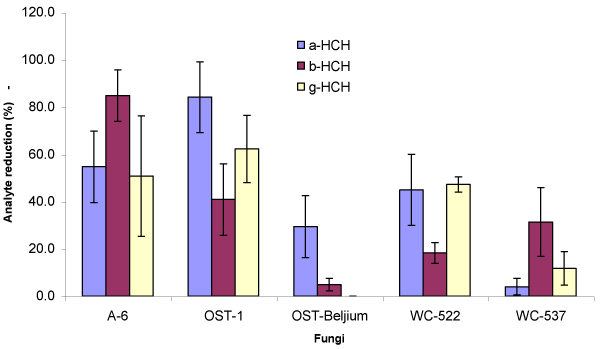 |
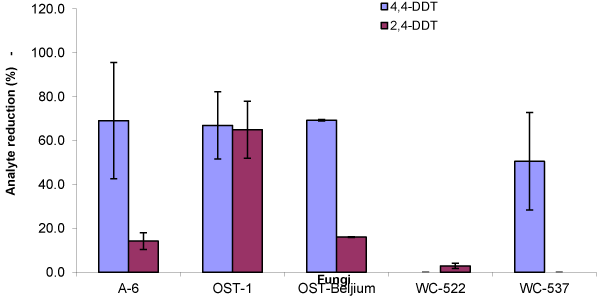 |
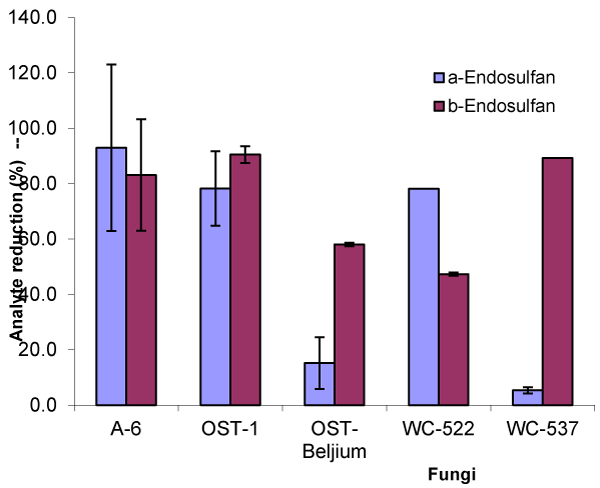 |
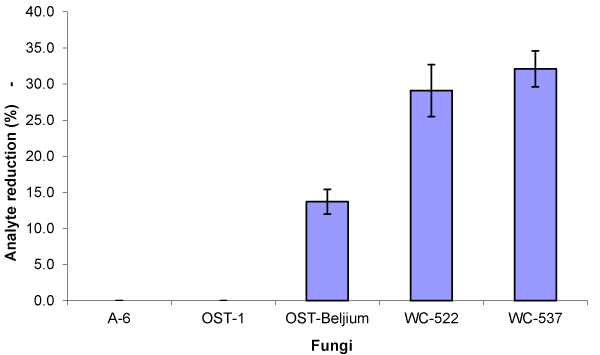 |
| Figure 1 | Figure 2 | Figure 3 | Figure 4 |
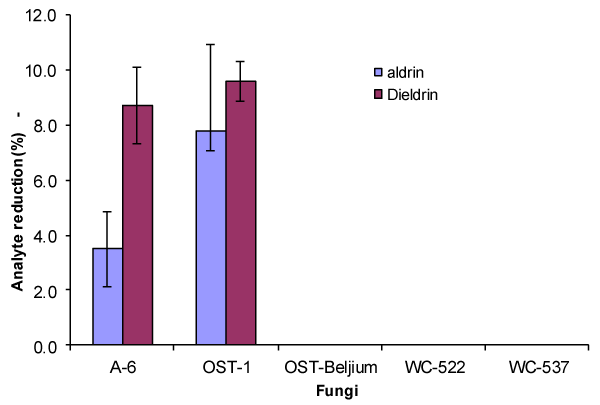 |
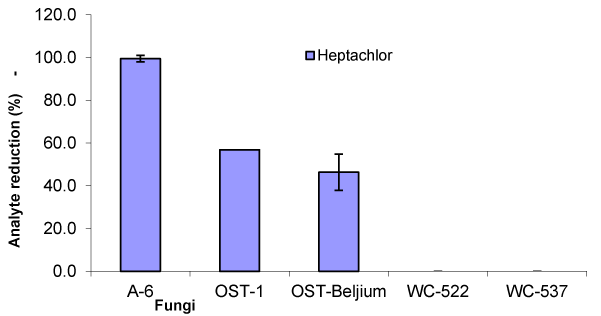 |
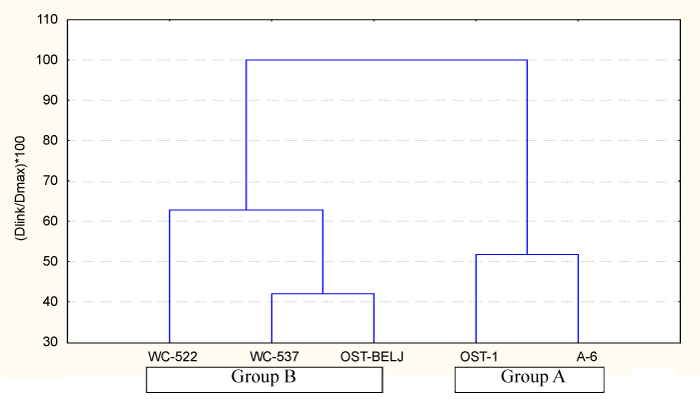 |
|
| Figure 5a | Figure 5b | Figure 6 |
Relevant Topics
- Anaerobic Biodegradation
- Biodegradable Balloons
- Biodegradable Confetti
- Biodegradable Diapers
- Biodegradable Plastics
- Biodegradable Sunscreen
- Biodegradation
- Bioremediation Bacteria
- Bioremediation Oil Spills
- Bioremediation Plants
- Bioremediation Products
- Ex Situ Bioremediation
- Heavy Metal Bioremediation
- In Situ Bioremediation
- Mycoremediation
- Non Biodegradable
- Phytoremediation
- Sewage Water Treatment
- Soil Bioremediation
- Types of Upwelling
- Waste Degredation
- Xenobiotics
Recommended Journals
Article Tools
Article Usage
- Total views: 15627
- [From(publication date):
September-2015 - Aug 29, 2025] - Breakdown by view type
- HTML page views : 10843
- PDF downloads : 4784
